2001 BMW 330Ci CONVERTIBLE cooling
[x] Cancel search: coolingPage 104 of 215
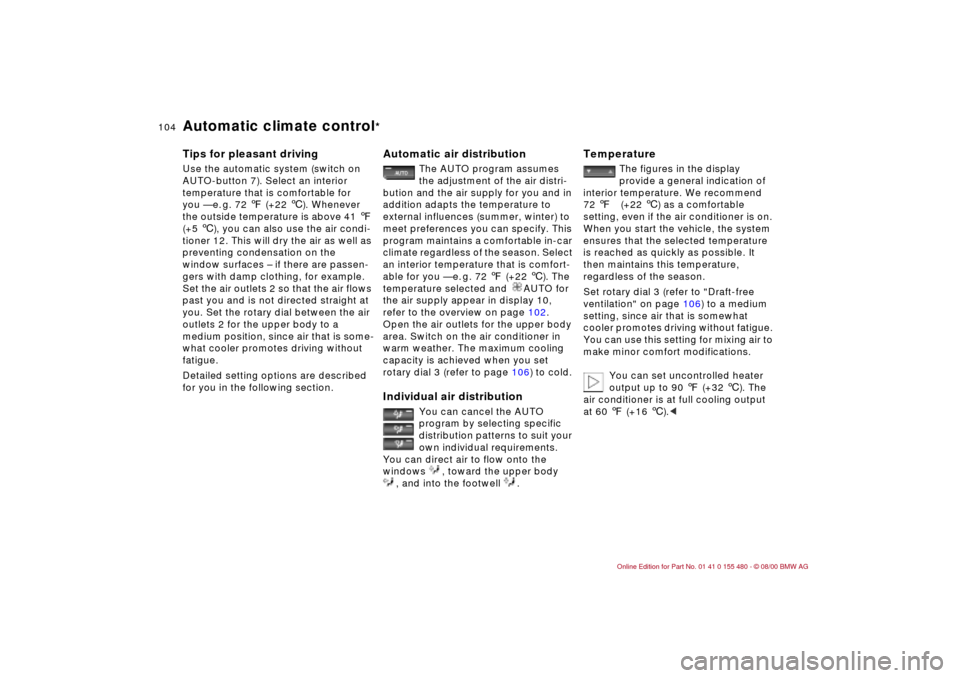
104n
Automatic climate control
*
Tips for pleasant drivingUse the automatic system (switch on
AUTO-button 7). Select an interior
temperature that is comfortable for
you Ñ e. g. 72 7 (+22 6). Whenever
the outside temperature is above 41 7
(+5 6), you can also use the air condi-
tioner 12. This will dry the air as well as
preventing condensation on the
window surfaces Ð if there are passen-
gers with damp clothing, for example.
Set the air outlets 2 so that the air flows
past you and is not directed straight at
you. Set the rotary dial between the air
outlets 2 for the upper body to a
medium position, since air that is some-
what cooler promotes driving without
fatigue.
Detailed setting options are described
for you in the following section.
Automatic air distribution
The AUTO program assumes
the adjustment of the air distri-
bution and the air supply for you and in
addition adapts the temperature to
external influences (summer, winter) to
meet preferences you can specify. This
program maintains a comfortable in-car
climate regardless of the season. Select
an interior temperature that is comfort-
able for you Ñ e. g. 72 7 (+22 6). The
temperature selected and AUTO for
the air supply appear in display 10,
refer to the overview on page 102.
Open the air outlets for the upper body
area. Switch on the air conditioner in
warm weather. The maximum cooling
capacity is achieved when you set
rotary dial 3 (refer to page 106) to cold.
Individual air distribution
You can cancel the AUTO
program by selecting specific
distribution patterns to suit your
own individual requirements.
You can direct air to flow onto the
windows , toward the upper body
, and into the footwell .
Temperature
The figures in the display
provide a general indication of
interior temperature. We recommend
72 7 (+22 6) as a comfortable
setting, even if the air conditioner is on.
When you start the vehicle, the system
ensures that the selected temperature
is reached as quickly as possible. It
then maintains this temperature,
regardless of the season.
Set rotary dial 3 (refer to "Draft-free
ventilation" on page 106) to a medium
setting, since air that is somewhat
cooler promotes driving without fatigue.
You can use this setting for mixing air to
make minor comfort modifications.
You can set uncontrolled heater
output up to 90 7 (+32 6). The
air conditioner is at full cooling output
at 60 7 (+16 6).<
Page 106 of 215
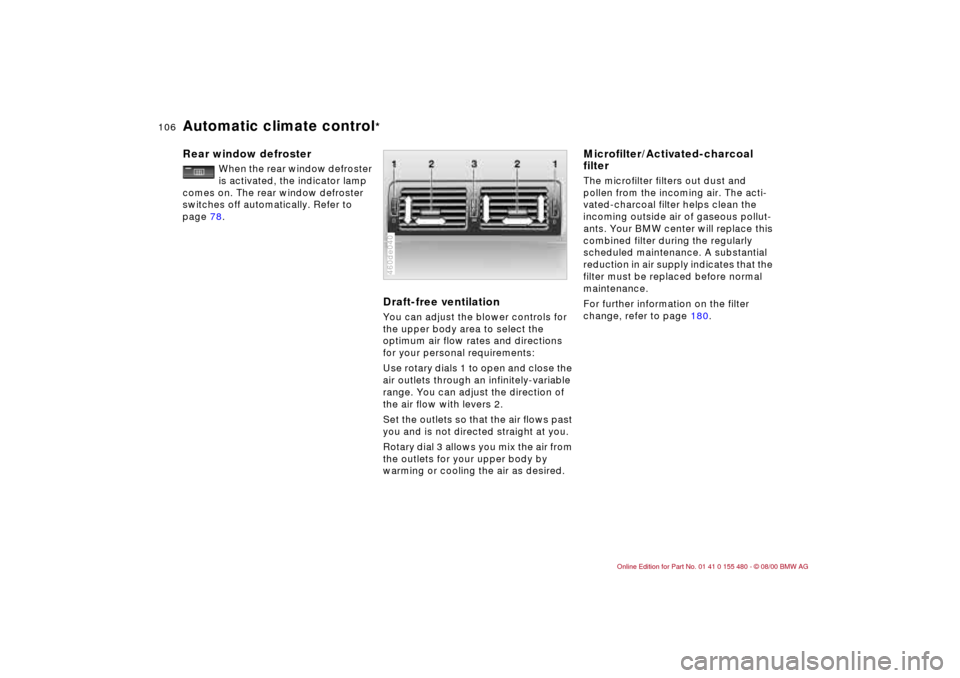
106n
Automatic climate control
*
Rear window defroster
When the rear window defroster
is activated, the indicator lamp
comes on. The rear window defroster
switches off automatically. Refer to
page 78.
Draft-free ventilation You can adjust the blower controls for
the upper body area to select the
optimum air flow rates and directions
for your personal requirements:
Use rotary dials 1 to open and close the
air outlets through an infinitely-variable
range. You can adjust the direction of
the air flow with levers 2.
Set the outlets so that the air flows past
you and is not directed straight at you.
Rotary dial 3 allows you mix the air from
the outlets for your upper body by
warming or cooling the air as desired.460de040
Microfilter/Activated-charcoal
filterThe microfilter filters out dust and
pollen from the incoming air. The acti-
vated-charcoal filter helps clean the
incoming outside air of gaseous pollut-
ants. Your BMW center will replace this
combined filter during the regularly
scheduled maintenance. A substantial
reduction in air supply indicates that the
filter must be replaced before normal
maintenance.
For further information on the filter
change, refer to page 180.
Page 125 of 215
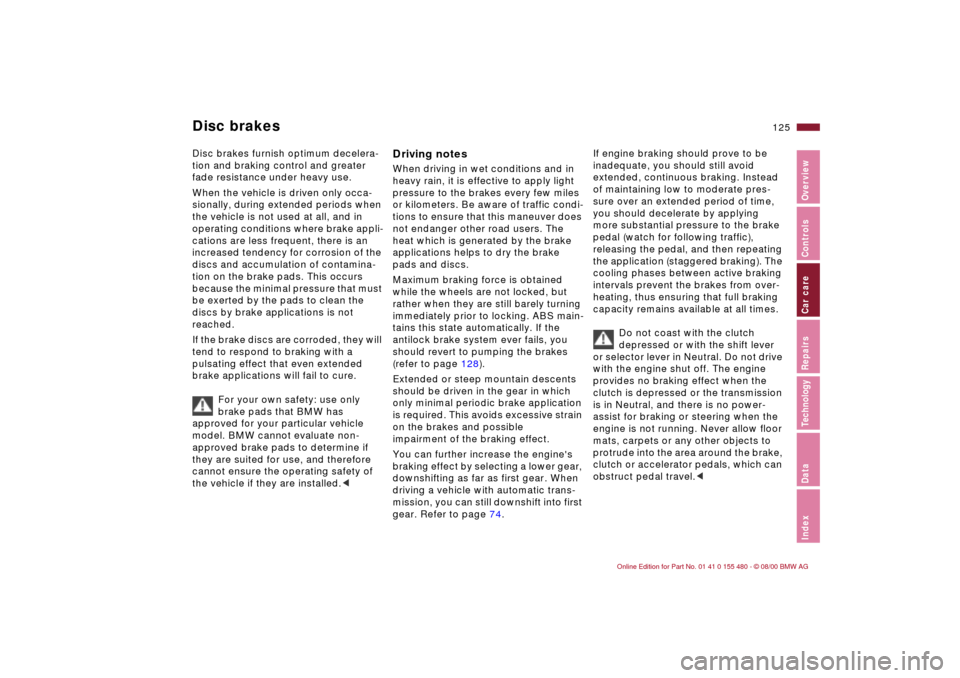
125n
IndexDataTechnologyRepairsCar careControlsOverview
Disc brakesDisc brakes furnish optimum decelera-
tion and braking control and greater
fade resistance under heavy use.
When the vehicle is driven only occa-
sionally, during extended periods when
the vehicle is not used at all, and in
operating conditions where brake appli-
cations are less frequent, there is an
increased tendency for corrosion of the
discs and accumulation of contamina-
tion on the brake pads. This occurs
because the minimal pressure that must
be exerted by the pads to clean the
discs by brake applications is not
reached.
If the brake discs are corroded, they will
tend to respond to braking with a
pulsating effect that even extended
brake applications will fail to cure.
For your own safety: use only
brake pads that BMW has
approved for your particular vehicle
model. BMW cannot evaluate non-
approved brake pads to determine if
they are suited for use, and therefore
cannot ensure the operating safety of
the vehicle if they are installed.<
Driving notesWhen driving in wet conditions and in
heavy rain, it is effective to apply light
pressure to the brakes every few miles
or kilometers. Be aware of traffic condi-
tions to ensure that this maneuver does
not endanger other road users. The
heat which is generated by the brake
applications helps to dry the brake
pads and discs.
Maximum braking force is obtained
while the wheels are not locked, but
rather when they are still barely turning
immediately prior to locking. ABS main-
tains this state automatically. If the
antilock brake system ever fails, you
should revert to pumping the brakes
(refer to page 128).
Extended or steep mountain descents
should be driven in the gear in which
only minimal periodic brake application
is required. This avoids excessive strain
on the brakes and possible
impairment of the braking effect.
You can further increase the engine's
braking effect by selecting a lower gear,
downshifting as far as first gear. When
driving a vehicle with automatic trans-
mission, you can still downshift into first
gear. Refer to page 74.If engine braking should prove to be
inadequate, you should still avoid
extended, continuous braking. Instead
of maintaining low to moderate pres-
sure over an extended period of time,
you should decelerate by applying
more substantial pressure to the brake
pedal (watch for following traffic),
releasing the pedal, and then repeating
the application (staggered braking). The
cooling phases between active braking
intervals prevent the brakes from over-
heating, thus ensuring that full braking
capacity remains available at all times.
Do not coast with the clutch
depressed or with the shift lever
or selector lever in Neutral. Do not drive
with the engine shut off. The engine
provides no braking effect when the
clutch is depressed or the transmission
is in Neutral, and there is no power-
assist for braking or steering when the
engine is not running. Never allow floor
mats, carpets or any other objects to
protrude into the area around the brake,
clutch or accelerator pedals, which can
obstruct pedal travel.<
Page 147 of 215
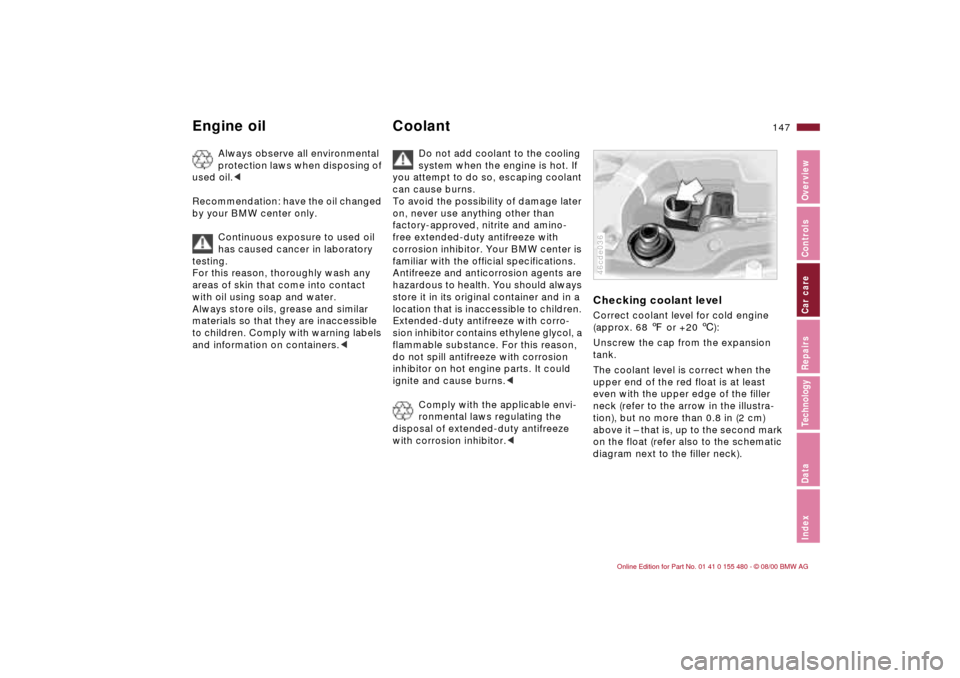
147n
IndexDataTechnologyRepairsCar careControlsOverview
Engine oil Coolant
Always observe all environmental
protection laws when disposing of
used oil.<
Recommendation: have the oil changed
by your BMW center only.
Continuous exposure to used oil
has caused cancer in laboratory
testing.
For this reason, thoroughly wash any
areas of skin that come into contact
with oil using soap and water.
Always store oils, grease and similar
materials so that they are inaccessible
to children. Comply with warning labels
and information on containers.<
Do not add coolant to the cooling
system when the engine is hot. If
you attempt to do so, escaping coolant
can cause burns.
To avoid the possibility of damage later
on, never use anything other than
factory-approved, nitrite and amino-
free extended-duty antifreeze with
corrosion inhibitor. Your BMW center is
familiar with the official specifications.
Antifreeze and anticorrosion agents are
hazardous to health. You should always
store it in its original container and in a
location that is inaccessible to children.
Extended-duty antifreeze with corro-
sion inhibitor contains ethylene glycol, a
flammable substance. For this reason,
do not spill antifreeze with corrosion
inhibitor on hot engine parts. It could
ignite and cause burns.<
Comply with the applicable envi-
ronmental laws regulating the
disposal of extended-duty antifreeze
with corrosion inhibitor.<
Checking coolant levelCorrect coolant level for cold engine
(approx. 68 7 or +20 6):
Unscrew the cap from the expansion
tank.
The coolant level is correct when the
upper end of the red float is at least
even with the upper edge of the filler
neck (refer to the arrow in the illustra-
tion), but no more than 0.8 in (2 cm)
above it Ð that is, up to the second mark
on the float (refer also to the schematic
diagram next to the filler neck).46cde036
Page 199 of 215
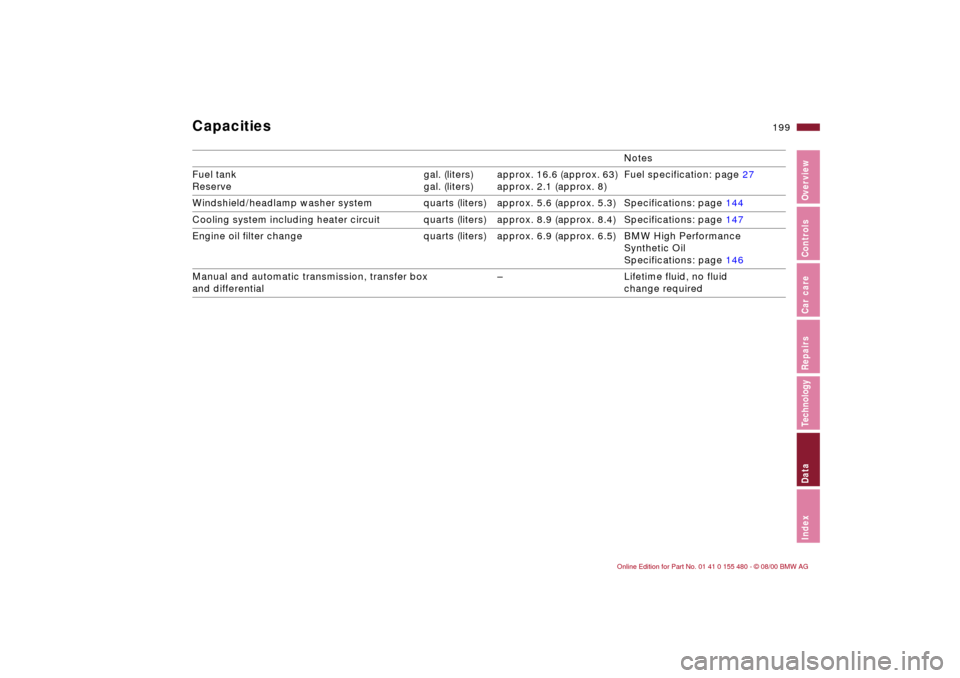
199n
IndexDataTechnologyRepairsCar careControlsOverview
Capacities
Notes
Fuel tank
Reserve gal. (liters)
gal. (liters)approx. 16.6 (approx. 63)
approx. 2.1 (approx. 8)Fuel specification: page 27
Windshield/headlamp washer system quarts (liters) approx. 5.6 (approx. 5.3) Specifications: page 144
Cooling system including heater circuit quarts (liters) approx. 8.9 (approx. 8.4) Specifications: page 147
Engine oil filter change quarts (liters) approx. 6.9 (approx. 6.5) BMW High Performance
Synthetic Oil
Specifications: page 146
Manual and automatic transmission, transfer box
and differentialÐ Lifetime fluid, no fluid
change required
Page 205 of 215

Everything from A to Z
205n
IndexDataTechnologyRepairsCar careControlsOverview
upholstery155
vinyl upholstery154
wool velour155
Cargo
loading114
securing114
Caring for the vehicle's
finish153
Cassette operation, refer
also to the Radio Owner's
Manual
Catalytic converter121
CBC (Cornering Brake
Control)21,123
CD operation, refer also to
the Radio Owner's Manual
Cellular phone111,129
refer to also the separate
Owner's Manual
Center (high-mount) brake
lamp171
Center armrest110
Central locking system34
button38
Changing a tire173
Changing a wheel173
Check Control83
Child restraints64
Child restraint
systems61,64
Child seat security65
Child's seat61,64
Cigarette lighter112 Cleaning headlamps78
Cleaning windshield77
Clock84
Cockpit16
Code, refer to the radio
Owner's Manual
Coin box, cup holder111
Combination switch76
Compression196
Computer83
refer also to the separate
Owner's Manual
Configure settings59
Consumption85
Contents10
Convertible top45
cleaning and care157
closing following an
electrical malfunction181
compartment panel41
convenience operation34
electrical fault181
emergency closure181
Coolant127,147,199
antifreeze127
Cooling system199
Copyright4
Cornering Brake Control
(CBC)21,123
Cruise control79
Cruising range85
Curb weight198
Current check indicator20
D
Data
dimensions197
engine196
technical196
weights198
Daytime-driving lamp
switch93
DBC (Dynamic Brake
Control)124
Deep water121
Defrost setting100,105
Defrostable rear
window98,106
Defrosting the
windows100,105
Digital clock84
Dimensions197
Dipstick145
Disc brakes125
Displacement196
Display lighting93
Displays18
Disposal
batteries178
engine oil147
Distance warning87
Diversity Antenna190
Door key32
Door locks, care127 Doors
emergency operation34
remote control35
unlocking and locking34
DOT Quality Grades133
Draft-free
ventilation99,106
Drive belts200
Driving hints121
Driving in winter127
Driving lamps93
DSC (Dynamic Stability
Control)22,88,189
Dynamic Brake Control
(DBC)124
Dynamic Stability Control
(DSC)22,88,189
E
Electric power windows44
Electrical accessories,
failure179
Electrical system200
Electronic vehicle
immobilizer33
Elements of operation16
Emergency closure181
Emergency operation
convertible top181
doors34
fuel filler door180
Energy Control81